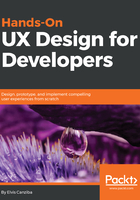
The planning phase
The planning phase is about understanding what you have been asked to do and documenting all the requirements from the discovery phase. Using the results and data that you got in the discovery phase, you can start creating clear documentation for the project, including answers to questions such as:
- What is the required budget for this project?
- What will be your team size?
- What is the timeline of the project and the deadline for each stage of the launch?
- What are the other related resources that need to be involved in the development of this project?
Having documented all that data, now it is even easier for us to provide a final estimation, budget, and expectation to our client.
Here, we can have the following two cases:
- The first case involves defining all the requirements for project development on the UX side, such as timing, budget, resources, and team sizes. Provide all these documents to the client and explain clearly to them what you, as a UX team, will achieve with this and also what you will provide to them. You need to be confident that the tools and techniques you choose will be the right ones to give you the insight you need within the constraints of the project.
So, in this first scenario, you are providing the required time, budget, and resources to the client and asking them to provide what is needed to agree on that road map. - The second case is where you have a limited time and budget provided by the client. However, you have to understand that it is your job, as a UX professional, to deliver the best user experience within the available time and budget. Also, you have to explain to the client that for a better product and better user experience, your suggestion is to go with the preceding approach. The good part of the UX project is that there is always a way you can add value to the project, regardless of the budget.
All clients like to start with a small budget and tight timing, but if you're able to justify why you need a better timeline and budget, it is more likely that you can get it from the client.
The tools and techniques you select are usually determined on the basis of timeline, budget, and the challenges that the project has. It is obvious that a different approach is required to design and develop a microsite from scratch compared to making a large-scale usability implementation on an existing huge web application or a product.
Often, you have to deal with clients and businesses that are unfamiliar with the importance of UX design for their product, and it often can be difficult to get the budget you want to involve users from the first stage of the process. However, it's really important for you, as a UX designer, to teach your client what a good user experience is and why it is always important to involve users from the beginning of product development.
As mentioned in the first chapter of this book, you can point out the following elements to the clients about why involving the user from the beginning is a good idea:
- It will cost less because you can note mistakes from beginning, and it will be easier to fix them right away
- We will get more time by finding what works and what doesn't at the beginning, instead of finding something in the last stage of the product development
- We will see the problems your users have during the first phase of trying to use your product
- We will realize whether the idea is worth creating with our initial approach or whether we need to customize the idea and adopt a different direction to solve that specific problem
In other words, we can say that it is better to test a product at the beginning phase with one user rather than at the end of it with hundreds of users.
The project usually begins with a lot of research into its users and, especially, competitors. This can give us unique insights into what the competitors are doing right or wrong, how they are doing it, and also why specific users are using their products.